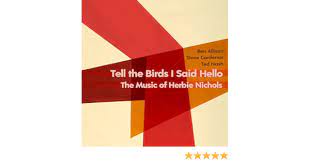Herbie Nichols Gets Another Fresh Revival
One of the coolest trios in jazz lays out previously unknown tunes by the not-quite-forgotten pianist-composer
Herbie Nichols, who died of leukemia in 1963 at the age of 44, was a jazz composer-pianist of vast talent, wit, and virtuosity, but little luck. He recorded just four albums (three for Blue Note, one for Bethlehem), none of which sold well; his music may have been at once too formalistic and too quirky for its time. He had a playful style, not unlike Thelonious Monk's, who was a friend and contemporary, though Nichols' sense of structure and harmony was higher-browed. (He was well-schooled in Prokofiev and Bartok.) He was “re-discovered” in the 1980s, as Michael Cuscuna, then digging through Blue Note’s vaults, unearthed several reels of unissued sessions (they were collected, along with the released but long-out-of-print tracks, in a 5-LP Mosaic Records box). Pianist Frank Kimbrough immersed himself in those albums, transcribed the solos, learned that reams of Nichols’ handwritten scores had been donated to the Library of Congress, and delved into that treasure trove as well.
In 1990, Kimbrough and bassist Ben Allison formed the Jazz Composers Collective, devoted to fusing their own sensibility with the works of undersung masters, and made Nichols one of their prime causes. (They also explored the works of Andrew Hill, as I noted in this space a month ago, in a review of A Prayer for Andrew, an album led by trumpeter Ron Horton, another JCC alum, devoted to Hill’s music.) Kimbrough, Allison, and Horton, along with saxophonists Ted Nash and Michael Blake, and drummer Tim Horner, formed a sextet called the Herbie Nichols Project and put out three albums (Love Is Proximity, Dr. Cyclops’ Dream, and Strange City). Most of their tracks had never been recorded, not even by Nichols; none had ever been arranged for ensembles larger than a trio; and the scores for the unrecorded material said nothing about tempo. The Collective hewed tight to Nichols’ labyrinths, while taking full advantage of the space he’d left for freedom. These were wonderful albums: engaging, heady, swirling with surprise.
Now, Allison and Nash, along with guitarist Steve Cardenas, have re-visited Nichols’ legacy with Tell the Birds I Said Hello, on Allison’s self-owned Sonic Camera label—and the surprises continue. In a press release (but, curiously, not on any liner notes), Allison tells an amazing story:
“In 2002 I received a phone call out of the blue from a cousin of Herbie Nichols. He said that he had a stack of original sheet music and mentioned several titles which were unfamiliar to me. My heart started racing… He promised to call back the next day to arrange a time when we could meet. He didn’t call back. Fifteen years later, Ted Nash received a call from the same person. We finally connected with him and upon seeing what he had, recognized Herbie’s handwriting immediately. His collection included some fantastic compositions that were new territory.”
Six of the eight tunes on Tell the Birds I Said Hello, including the title track, are from this new stash. (The other two, “Enrapture” and “Swan Song,” were on Herbie Nichols Project albums.) Allison’s description of these pieces—“full of life, humor, and clever twists and turns”—hit the mark precisely.
This is the 4th album by the Allison-Nash-Cardenas trio. Their previous outings were devoted to the music of Jim Hall (Quiet Revolution), Leonard Bernstein (Somewhere Else—West Side Story Songs, my favorite), and Carla Bley (Healing Power), and the Nichols survey forms a perfect coda or (I hope this isn’t the finale) new chapter.
There’s no drummer here, but don’t mistake this for “chamber jazz.” This is rollicking music—quietly, deftly, subtly rollicking, but rollicking nonetheless. The interplay is dancing-in-your-head magical: Allison’s percussive plucking, Cardenas’ twangy chord-strums or single-note counterpoint, and Nash’s breezy warm blowing—the three trading off melody, harmony, and time-keeping, or burrowing into one or all three in parallel or slightly off-centered patterns: this is very, very cool, in a good, not at all clichéd sense of that word.
The session was recorded in 96/24 high-rez digital by Matt Balitsaris at his Maggie’s Farm Studio in Pennsylvania, where these musicians and a lot of others have made many albums. Nash blew his sax into an RCA 44B ribbon mic. Cardenas used a Fender Deluxe Reverb 65 picked up by an SM57 dynamic. Allison’s bass was captured by two Neumann U87s, with no direct input. The sound is excellent, the instruments infused with just the right tonal colors, bellowing just the right amount of air, the ambience properly blooming.











































.png)








